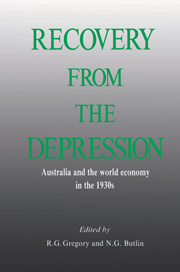Book contents
- Frontmatter
- Contents
- LIST OF AUTHORS
- LIST OF FIGURES
- LIST OF TABLES
- PREFACE
- 1 AN OVERVIEW
- 2 THE AUSTRALIAN RECOVERY OF THE 1930s IN INTERNATIONAL COMPARATIVE PERSPECTIVE
- 3 THE RECOVERY OF THE 1930s AND ECONOMIC POLICY IN BRITAIN
- 4 A MACRO INTERPRETATION OF RECOVERY: AUSTRALIA AND CANADA
- 5 DEPRESSION AND RECOVERY IN NEW ZEALAND
- 6 THE JAPANESE ECONOMY AND ECONOMIC POLICY IN THE 1930s
- 7 THE BATTLE OF THE PLANS: A MACROECONOMETRIC MODEL OF THE INTERWAR ECONOMY
- 8 AUSTRALIAN BUDGETARY POLICIES IN THE 1930s
- 9 MONETARY POLICY IN DEPRESSION AND RECOVERY
- 10 SHARING THE BURDEN: THE AUSTRALIAN LABOUR MARKET DURING THE 1930s
- 11 MANUFACTURING AND ECONOMIC RECOVERY IN AUSTRALIA, 1932–1937
- 12 AGRICULTURE AND THE RECOVERY FROM THE DEPRESSION
- 13 UNEMPLOYMENT AND THE AUSTRALIAN ECONOMIC RECOVERY OF THE 1930s
- 14 GOVERNMENT UNEMPLOYMENT RELIEF IN THE 1930s: AID OR HINDRANCE TO RECOVERY?
- 15 UNEQUAL SACRIFICE: DISTRIBUTIONAL ASPECTS OF DEPRESSION AND RECOVERY IN AUSTRALIA
- REFERENCES
- INDEX
12 - AGRICULTURE AND THE RECOVERY FROM THE DEPRESSION
Published online by Cambridge University Press: 24 November 2009
- Frontmatter
- Contents
- LIST OF AUTHORS
- LIST OF FIGURES
- LIST OF TABLES
- PREFACE
- 1 AN OVERVIEW
- 2 THE AUSTRALIAN RECOVERY OF THE 1930s IN INTERNATIONAL COMPARATIVE PERSPECTIVE
- 3 THE RECOVERY OF THE 1930s AND ECONOMIC POLICY IN BRITAIN
- 4 A MACRO INTERPRETATION OF RECOVERY: AUSTRALIA AND CANADA
- 5 DEPRESSION AND RECOVERY IN NEW ZEALAND
- 6 THE JAPANESE ECONOMY AND ECONOMIC POLICY IN THE 1930s
- 7 THE BATTLE OF THE PLANS: A MACROECONOMETRIC MODEL OF THE INTERWAR ECONOMY
- 8 AUSTRALIAN BUDGETARY POLICIES IN THE 1930s
- 9 MONETARY POLICY IN DEPRESSION AND RECOVERY
- 10 SHARING THE BURDEN: THE AUSTRALIAN LABOUR MARKET DURING THE 1930s
- 11 MANUFACTURING AND ECONOMIC RECOVERY IN AUSTRALIA, 1932–1937
- 12 AGRICULTURE AND THE RECOVERY FROM THE DEPRESSION
- 13 UNEMPLOYMENT AND THE AUSTRALIAN ECONOMIC RECOVERY OF THE 1930s
- 14 GOVERNMENT UNEMPLOYMENT RELIEF IN THE 1930s: AID OR HINDRANCE TO RECOVERY?
- 15 UNEQUAL SACRIFICE: DISTRIBUTIONAL ASPECTS OF DEPRESSION AND RECOVERY IN AUSTRALIA
- REFERENCES
- INDEX
Summary
Background
During the 1920s the prices received by farmers for agricultural produce fluctuated widely while wages, the prices of manufactured goods and the price of distributing them tended to increase. In the 1930s wages and the price of all products declined dramatically. However, farm product prices fell more than manufactured goods prices and, for the most part, more than wages.
Wages and the price of all goods and services remained low during the period 1930–31 to 1932–33. Wool prices recovered in 1933–34, the price of services in 1934–35, the price of wheat and wages in 1935–36 and the price of butter and manufactured goods in 1936–37 (Table 12.1). Thus the three years 1930–31 to 1932–33 can be regarded as the period of depression and the following three years from 1933–34 to 1936–37 as the recovery phase.
The expected response in the depression would have been a decline in production and employment in both the farm and non-farm sectors, with the decline in the former being more marked, as price falls were greater for agricultural products than for manufactured goods. In the recovery phase the expected response would have been for a greater increase in production in the farm sector, in view of the larger previous decline in product prices in the rural sector and the recovery of most farm product prices occurring ahead of manufactured goods.
An examination of the Australian economy indicates that the expected response did not occur. Employment in agriculture as a proportion of total employment increased during the depression, while there was a decrease in the proportion of the workforce employed in manufacturing and construction.
- Type
- Chapter
- Information
- Recovery from the DepressionAustralia and the World Economy in the 1930s, pp. 273 - 288Publisher: Cambridge University PressPrint publication year: 1989



